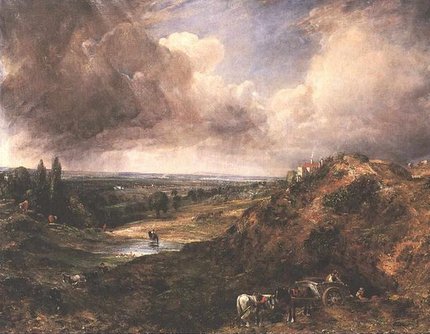
He brushed away the thunder, then the clouds,
Then the colossal illusion of heaven. Yet still
The sky was blue. He wanted imperceptible air.
He wanted to see....
—Wallace Stevens
1
You see the stormy sky at once, and then gradually the rocky hills in partial sunlight
with a house (portrayed with a curious lack of perspective), then the trees, and,
finally, the valley. The eye runs over these things quickly, and settles on the human
scene in foreground right—an unhitched white horse and a black one still hitched
up to a large wheeled wagon, and two human figures.
We stop and wonder what they’re doing; some kind of digging, perhaps, or eating
a meal al fresco. But, then we notice in the middle ground another human
figure on a horse wading out into the pond, and still another horse pulling what looks
like a plow. There are two more dark animal figures just beyond, but I can’t
tell if they’re horses or cows.
The human figures suggest story—some dramatic meaning missing from all the
scenery—and that story draws our attention away from the much larger but
inanimate landscape. Put here perhaps only to humanize the panorama, these human
figures steal the scene.
in some medieval
paintings they made perspective
reflect social class—
the higher the rank, the larger
the figure. Serfs were tiny.
in southwest England
the gorse grows wild from hedges
spreads across the fields
gold and beautiful, but its leaves
turn to thorns as they mature
you can feel just how
he strained to reach the sublime
the underlying
menace of the natural world
but it boils down to a storm
2
He came back to the same landscape, but he dressed it differently each
time—horses and donkeys, boys in red waistcoats and laborers digging at the
sand, white skies, gray and black skies, and rainbows. Where an elegant house
eventually stood, there had in other sketches been rocks and peasants walking on the
ridge, more donkeys and horses and, finally, a windmill. In one version a man in a
red waistcoat unloads manure or dirt or maybe sand; horses and plows and wagons
everywhere, horses stand in water to their fetlocks, and there’s a small black
and white dog. I found seven paintings of the pond, all from this general vantage,
and every one had a different sky (although I wonder, did he ever paint a blue sky
without clouds?).
horses run so fast
because they are on their toes
but sometimes they just
stand around whisking the flies
away with Shiva’s tail
people painted in
and painted out, from picture
to picture. Captain
Midnight’s flip-it movies
here and gone like dream figures
water in the pond
he painted as reflections
of the sky. Mirrors
turn everything back on itself
there’s no way of looking through
3
Just over the immediate ridge of hills, a wide valley reaches to the horizon where
it is capped with another ridge. Not far from London (he could receive messages from
the city in less than an hour), yet he was away from it, in another place entirely.
He was given to ignoring the urban spill of poor out into Hampstead, the encampments
of Gypsies, the shantytowns filled with workmen driven off the land by machinery and
the Enclosure Acts. The railroad “branch” was there, but not portrayed.
peaceful, idyllic
you would have to say he painted
what was his own dream
world, the vanishing peasants
and the easy simple life
take a taxi now
through Highgate and Kentish Town
or the A-401
the heath’s crisscrossed with walking paths
his house now at “40 Well Walk”
busses, trains and cars
the thick noises of London
the heath now a park
for weekends or walking dogs
in the right light you can’t tell
is a retired university professor now living in Northampton, Massachusetts, and
writing poetry and flash fiction since 2006. His poems have appeared in: Jack
Magazine, Shampoo, Review Americana, Tipton, Barnwood, Abramelin, Simply Haiku,
Haibun Today, Atlas Poetica, Blue and Yellow Dog, Shot Glass, Sketchbook, Skylark,
Six Minute Magazine, Cricket Online Review, Red Booth Review, Linden Avenue Literary
Journal, Inner Art Journal, Prune Juice, Rattle, Blackbox Manifold, and
Ink, Sweat, and Tears.
He has also published a poetry e-chapbook in the 2River series, entitled La Vida
de Piedra y de Palabra (a free translation of Neruda); a tragic historical
western in poetry and prose, “Five Episodes in the Navajo Degradation,”
in Lacuna; and “The Turn of Art,” a short poetical drama
pitting Picasso against Matisse, composed in verse and prose, which appeared in
Fiction International.
⚡
Simple Tanka Prose for the Seasons,
a quartet by Tarlton in Rattle (Issue 47: Tribute to Japanese Forms, Spring
2015)
⚡
La Vida de Piedra y de Palabra:
Improvisations on Pablo Neruda’s Macchu Picchu, Tarlton’s
e-chapbook of a dozen poems, with the author reading several aloud; chapbook is also
available in PDF, with cover art by Ann S. Knickerbocker
